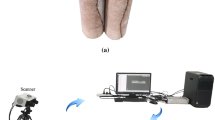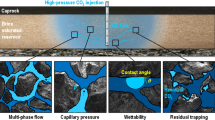Abstract
This study tried to examine the feasibility of enzyme-induced calcium carbonate precipitation (EICP) for CO2 leakage prevention in a subsurface condition. For this, the effects of 1) concentrations of urease enzyme and reactants (urea and CaCl2), 2) initial pH (3–9), and 3) temperature (30–50 °C) on the precipitation of calcium carbonate were tested in the batch experiments. In addition, the core-plugging experiment was conducted to test the potential application of EICP to a porous medium with high permeability. The batch experiments showed that the 0.25 M urea was completely hydrolyzed by urease (above 1000 U/l). However, 0.4 M and 0.5 M urea were not completely decomposed because of the insufficient quantity of urease. Our result also showed that urea hydrolysis was not observed at pH 3, while the efficiency of calcite precipitation was not affected in the pH range of 5 to 9. Temperature also affected the hydrolysis of urea. The efficiency of calcite precipitation increased with increasing temperature from 30 °C to 50 °C. In addition, the result of the core-plugging experiment showed that the permeability of the sandstone core decrease by approximately 42% due to the precipitation of calcite in the pores. From our results, this study suggested that EICP can be a potential for CO2 leakage prevention from a storage reservoir within the pH and temperature ranges of this study.
Similar content being viewed by others
References
Anbu, P., Kang, C.H., Shin, Y.J., and So, J.S., 2016, Formations of calcium carbonate minerals by bacteria and its multiple applications. SpringerPlus, 5, 250. https://doi.org/10.1186/s40064-016-1869-2
Bildstein, O., Kervévan, C., Lagneau, V., Delaplace, P., Crédoz, A., Audigane, P., Perfetti, E., Jacquemet, N., and Jullien, M., 2010, Integrative modeling of caprock integrity in the context of CO2 storage: evolution of transport and geochemical properties and impact on performance and safety assessment. Oil & Gas Science and Technology — Revue d’IFP Energies nouvelles, 65, 485–502. https://doi.org/10.2516/ogst/2010006
Blakeley, R.L. and Zerner, B., 1984, Jack bean urease: the first nickel enzyme. Journal of Molecular Catalysis, 23, 263–292.
Busch, A., Amann, A., Bertier, P., Waschbusch, M., and Krooss, B.M., 2010, The significance of caprock sealing integrity for CO2 storage. SPE International Conference on CO2 Capture, Storage, and Utilization, New Orleans, Nov. 10–12, SPE-139588, p. 300–307. https://doi.org/10.2118/139588-MS
Carmona, J.P.S.F., Venda Oliveira, P.J., Lemos, L.J.L., and Pedro, A.M.G., 2018, Improvement of a sandy soil by enzymatic calcium carbonate precipitation. Geotechnical Engineering, 171, 3–15.
Cheng, L., Shahin, M.A., Cord-Ruwisch, R., Addis, M., Hartanto, T., and Elms, C., 2014, Soil stabilization by microbial-induced calcite precipitation (MICP): investigation into some physical and environmental aspects. The 7th International Congress on Environment Geotechnics, Nov. 10–14, Melbourne, p. 1105–1112.
Cunningham, A.B., Class, H., Ebigbo, A., Gerlach, R., Phillips, A.J., and Hommel, J., 2019, Field-scale modeling of microbially induced calcite precipitation. Computational Geosciences, 23, 399–414.
Cunningham, A.B., Phillips, A.J., Troyer, E., Lauchnor, E., Hiebert, R., Gerlach, R., and Spangler, L., 2014, Wellbore leakage mitigation using engineered biomineralization. Energy Procedia, 63, 4612–4619.
Cuthbert, M.O., McMillan, L.A., Handley-Sidhu, S., Riley, M.S., Tobler, D.J., and Rhoenix, V.R., 2013, A field and modeling study of fractured rock permeability reduction using microbially induced calcite precipitation. Environmental Science and Technology, 47, 13637–13643.
De Muynck, W., De Belie, N., and Verstraete, W., 2010, Microbial carbonate precipitation in construction materials: a review. Ecological Engineering, 36, 118–136.
De Silva, G.P.D., Ranjith, P.G., and Perera, M.S.A., 2015, Geochemical aspects of CO2 sequestration in deep saline aquifers: a review. Fuel, 155, 128–143.
Ebigbo, A., Phillips, A., Gerlach, R., Helmig, R., Cunningham, A.B., Class, H., and Spangler, L.H., 2012, Darcy-scale modeling of microbially induced carbonate mineral precipitation in sand columns. Water Resources Research, 48, W07519, https://doi.org/10.1029/2011WR011714
Frieling, Z.J., 2019, Urease immobilization for advancing enzyme-induced calcium carbonate precipitation applications. M.S. Thesis, Montana State University, Bozeman, 103 p.
Gaus, I., Azaroual, M., and Czernichowski-Lauriol, I., 2005, Reactive transport modelling of the impact of CO2 injection on the clayey cap rock at Sleipner (North Sea). Chemical Geology, 217, 319–337.
Gebru, K.A., Kidanemariam, T.G., and Gebretinsae, H.K., 2021, Biocement production using microbially induced calcite precipitation (MICP) method: a review. Chemical Engineering Science, 238, 116610. https://doi.org/10.1016/j.ces.2021.116610
Gherardi, F., Xu, T., and Pruess, K., 2007, Numerical modeling of self-limiting and self-enhancing caprock alteration induced by CO2 storage in a depleted gas reservoir. Chemical Geology, 244, 103–129.
IPCC, 2005, Special report on carbon dioxide capture and storage. Working Group III of the Intergovernmental Panel on Climate Change, Cambridge University Press, Cambridge, 431 p.
KIGAM, 2005, Mid- and long-term planning of research and development on geothermal resources utilization technologies. Final Report 2004-R-NC02-P-01-0-000, Korea Institute of Geoscience and Mineral Resources (KIGAM), Daejeon, Korea, 104 p. (in Korean with English abstract).
Kirkland, C.M., Akyel, A., Hiebert, R., McCloskey, J., Kirksey, J., Cunningham, A.B., Gerlach, R., Spangler, L., and Phillips, A.J., 2021, Ureolysis-induced calcium carbonate precipitation (UICP) in the presence of CO2-affected brine: a field demonstration. International Journal of Greenhouse Gas Control, 109, 103391. https://doi.org/10.1016/j.ijggc.2021.103391
Kirkland, C.M., Norton, D., Firth, O., Eldring, J., Cunningham, A.B., Gerlach, R., and Phillips, A.J., 2019, Visualizing MICP with X-ray M-CT to enhance cement defect sealing. International Journal of Greenhouse Gas Control, 86, 93–100.
Krajewska, B., 2009, Ureases I. Functional, catalytic and kinetic properties: a review. Journal of Molecular Catalysis B: Enzymatic, 59, 9–21.
Krajewska, B., 2018, Urease-aided calcium carbonate mineralization for engineering applications: a review. Journal of Advanced Research, 13, 59–67.
Landa-Marbán, D., Tveit, S., Kumar, K., and Gasda, S.E., 2021, Practical approaches to study microbially induced calcite precipitation at the field scale. International Journal of Greenhouse Gas Control, 106, 103256. https://doi.org/10.1016/j.ijggc.2021.103256
Lauchnor, E.G., Schultz, L.N., Bugni, S., Mitchell, A.C., Cunningham, A.B., and Gerlach, R., 2013, Bacterially induced calcium carbonate precipitation and strontium coprecipitation in a porous media flow system. Environmental Science and Technology, 47, 1557–1564.
Marzadori, C., Miletti, S., Gessa, C., and Ciurli, S., 1998, Immobilization of jack bean urease on hydroxyapatite: urease immobilization in alkaline soils. Soil Biology and Biochemistry, 30, 1485–1490.
Mateo, C., Palomo, J.M., Fernandez-Lorente, G., Guisan, J.M., and Fernandez-Lafuente, R., 2007, Improvement of enzyme activity, stability and selectivity via immobilization techniques. Enzyme and Microbial Technology, 40, 1451–1463.
Minto, J.M., Hinger, F.F., Benson, S.M., and Lunn, R.J., 2017, X-ray CT and multiphase flow characterization of a ‘bio-grouted’ sandstone core: the effect of dissolution on seal longevity. International Journal of Greenhouse Gas Control, 64, 152–162.
Minto, J.M., MacLachlan, E., El Mountassir, G., and Lunn, R.J., 2016, Rock fracture grouting with microbially induced carbonate precipitation. Water Resources Research, 52, 8827–8844.
Mitchell, A.C., Dideriksen K., Spangler, L.H., Cunningham, A.B., and Gerlach, R., 2010, Microbially enhanced carbon capture and storage by mineral-trapping and solubility-trapping. Environmental Science and Technology, 44, 5270–5276.
Nemati, M. and Voordouw, G., 2003, Modification of porous media permeability, using calcium carbonate produced enzymatically in situ. Enzyme and Microbial Technology, 33, 635–642.
Okwadha, G.D.O. and Li, J., 2010, Optimum conditions for microbial carbonate precipitation. Chemosphere, 81, 1143–1148.
Omoregie, A.I., Khoshdelnezamiha, G., Senian, N., Ong, D.E.L., and Nissom, P.M., 2017, Experimental optimization of various cultural conditions on urease activity for isolated Sporosarcina pasteurii strains and evaluation of their biocement potentials. Ecological Engineering, 109, 65–75.
Park, J., Choi, B.-Y., Lee, M., and Yang, M., 2021, Porosity changes due to analcime in a basaltic tuff from the Janggi Basin, Korea: experimental and geochemical modeling study of CO2-water-rock interactions. Environmental Earth Sciences, 80, 1–13.
Parkhurst D.L. and Appelo, C.A.J., 2013, Description of input and examples for PHREEQC version 3: a computer program for speciation, batch-reaction, one-dimensional transport, and inverse geochemical calculations. Techniques and Methods 6-A43, US Geological Survey, Reston, 497 p. https://doi.org/10.3133/tm6A43
Phillips, A.J., Cunningham, A.B., Gerlach, R., Hiebert, R., Hwang, C., Lomans, B.P., Westrich, J., Mantilla, C., Kirksey, J., Esposito, R., and Spangler, L., 2016, Fracture sealing with microbially-induced calcium carbonate precipitation: a field study. Environmental Science and Technology, 50, 4111–4117.
Phillips, A.J., Lauchnor, E., Eldring, J.J., Esposito, R., Mitchell, A.C., Gerlach, R., Cunningham, A.B., and Spangler, L.H., 2013, Potential CO2 leakage reduction through biofilm-induced calcium carbonate precipitation. Environmental Science and Technology, 47, 142–149.
Rodriguez-Blanco, J.D., Shaw, S., and Benning, L.G., 2011, The kinetics and mechanisms of amorphous calcium carbonate (ACC) crystallization to calcite, via vaterite. Nanoscale, 3, 265–271.
Sahrawat, K.L., 1984, Effects of temperature and moisture on urease activity in semi-arid tropical soils. Plant and Soil, 78, 401–408.
Shukla, R., Ranjith, P., Haque, A., and Choi, X., 2010, A review of studies on CO2 sequestration and caprock integrity. Fuel, 89, 2651–2664.
Sondi, I. and Matijević, E., 2001, Homogeneous precipitation of calcium carbonates by enzyme catalyzed reaction. Journal of Colloid and Interface Science, 238, 208–214.
Spanos, N. and Koutsoukos, P.G., 1998, Kinetics of precipitation of calcium carbonate in alkaline pH at constant supersaturation. Spontaneous and seeded growth. The Journal of Physical Chemistry B, 102, 6679–6684.
Sun, X., Miao, L., and Wu, L., 2020, Applicability and theoretical calculation of enzymatic calcium carbonate precipitation for sand improvement. Geomicrobiology Journal, 37, 389–399.
Tobler, D.J., Maclachlan, E., and Phoenix, V.R., 2012, Microbially mediated plugging of porous media and the impact of differing injection strategies. Ecological Engineering, 42, 270–278.
Tobler, D.J., Minto, J.M., El Mountassir, G., Lunn, R.J., and Phoenix, V.R., 2018, Microscale analysis of fractured rock sealed with microbially induced CaCO3 precipitation: influence on hydraulic and mechanical performance. Water Resources Research, 54, 8295–8308.
Whiffin, V.S., van Paassen, L.A., and Harkes, M.P., 2007, Microbial carbonate precipitation as a soil improvement technique. Geomicrobiology Journal, 24, 417–423.
Xu, T., Apps, J.A., and Pruess, K., 2003, Reactive geochemical transport simulation to study mineral trapping for CO2 disposal in deep arenaceous formations. Journal of Geophysical Research: Solid Earth, 108, 2071. https://doi.org/10.1029/2002JB001979
Yasuhara, H., Neupane, D., Hayashi, K., and Okamura, M., 2012, Experiments and predictions of physical properties of sand cemented by enzymatically-induced carbonate precipitation. Soils and Foundations, 52, 539–549.
Acknowledgments
This study was supported by the Basic Research Program of the Korea Institute of Geoscience and Mineral Resources [KIGAM].
Author information
Authors and Affiliations
Corresponding author
Additional information
Publisher’s Note
Springer Nature remains neutral with regard to jurisdictional claims in published maps and institutional affiliations.
Rights and permissions
About this article
Cite this article
Park, J., Choi, BY. Feasibility study of enzyme-induced calcium carbonate precipitation (EICP) for CO2 leakage prevention. Geosci J 26, 279–288 (2022). https://doi.org/10.1007/s12303-021-0033-3
Received:
Accepted:
Published:
Issue Date:
DOI: https://doi.org/10.1007/s12303-021-0033-3




